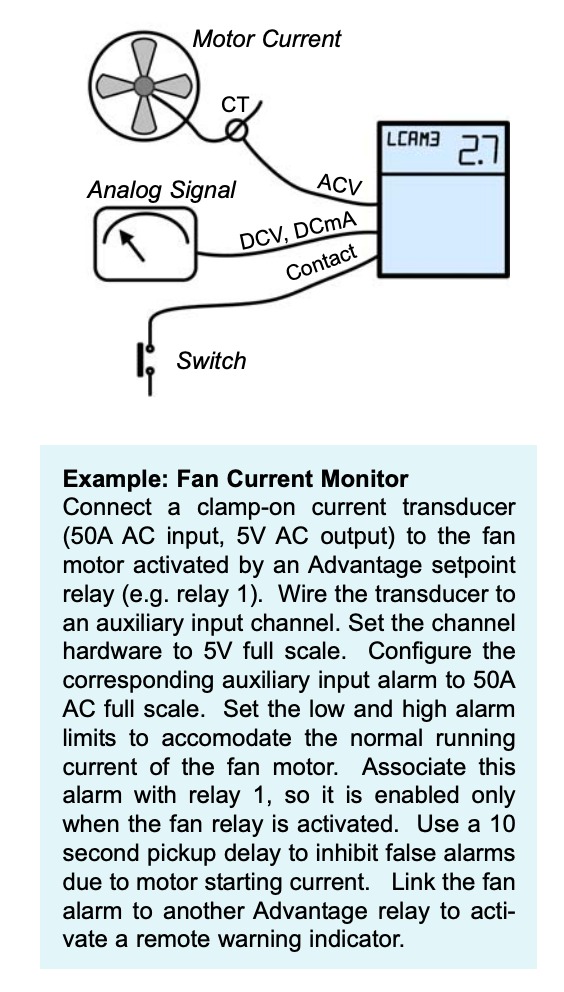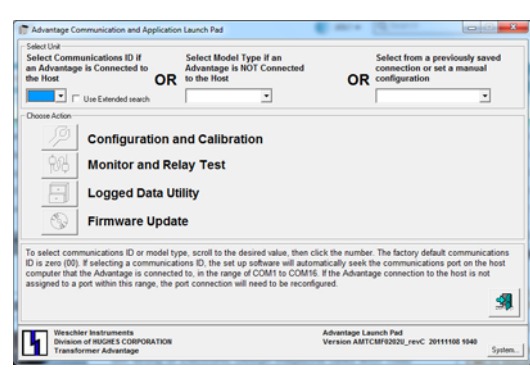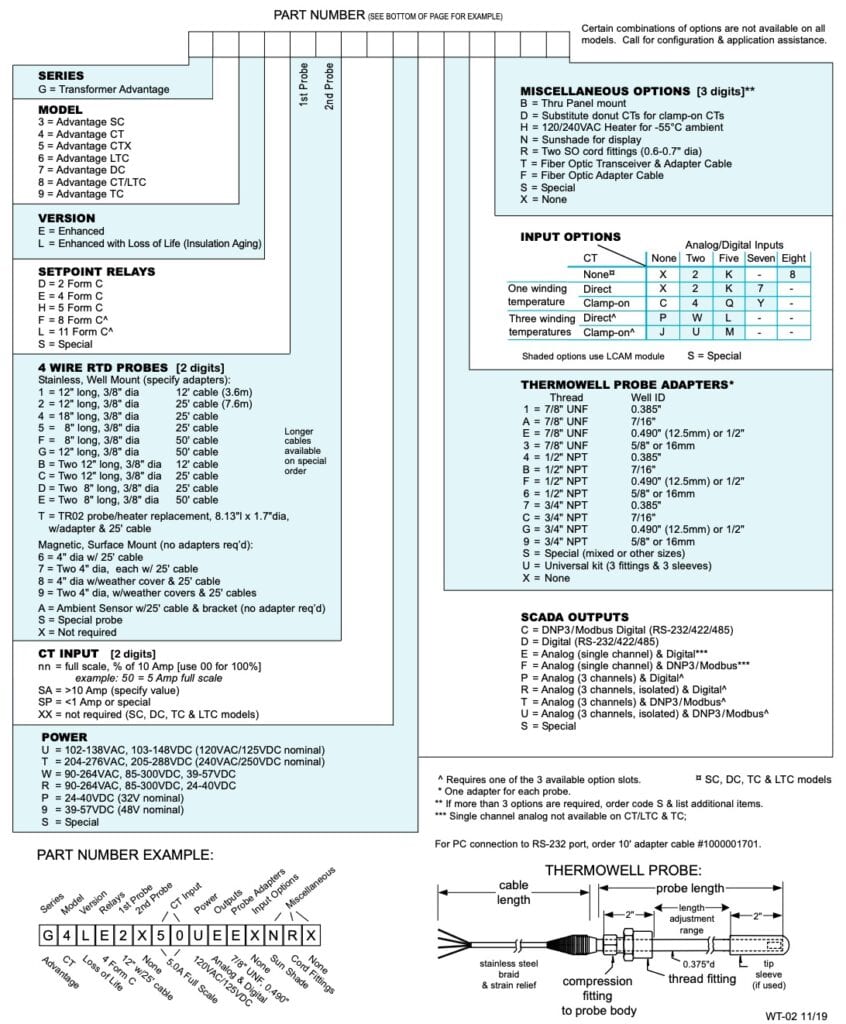-
- Direct Oil Temperature
- Calculated or Simulated Winding Temperatures
- LTC Temperature Difference (LTC Models)
- Loss of Life (Insulation Aging) Option
- Single, Dual and Three RTD Units
- Multi-Stage Fan/Pump Control with Readback
- Auxiliary Analog & Digital Inputs
- Weatherproof NEMA 4X Metal Case
- SCADA Ready – Analog, Digital, DNP3, Modbus
- Enhanced Windows Setup & Monitoring Software

Simulated Winding Temperature
This is the traditional method for indicating transformer winding temperature. A heated thermowell, driven by a bushing CT, simulates the winding temperature rise above the oil temperature. This temperature rise is calibrated by the transformer manufacturer at full load. Performance is optimized for steady-state or slowly changing loads. The simulated winding method is often used as a direct replacement for an analog winding gauge when higher accuracy, more configuration flexibility or a SCADA interface is required. One, two and three-channel Advantage models support this method on new or existing transformers.
Calculated Winding Temperature
A newer method uses oil temperature and load current to calculate winding temperature, based on IEEE guidelines. The Transformer Advantage analyzes transformer parameters to determine thermal time constants for the oil and windings. These time constants are changed dynamically based on load and cooling conditions. Rate of change information is also utilized in the Weschler CT algorithm to further improve the winding temperature accuracy. This is particularly important when operating above nameplate rating. Three Advantage models use the CT method for winding temperature indication.
TRANSFORMER ADVANTAGE
Simulated Winding Models
 Advantage SC
Advantage SC
The single-channel Advantage SC directly measures one liquid temperature using either an RTD probe installed in a thermowell or a magnetic probe mounted on the side of the tank. The display prompt can be set to Top Oil, Fluid, Winding, HWinding, YWinding, XWinding, Ambient, or Bottom Oil. Winding temperature is simulated by using the RTD probe in a heated thermowell. Full-scale temperature can be set to either 200°C or 250°C. During setup, each form C setpoint relay is individually configured to activate at different values of the measured temperature, time of day or a remote command. Hysteresis, non-alarm state and sensor fail response are also individually setable. Analog output and up to eleven setpoint relays are available in the SC model.
Advantage DC
 The Advantage DC provides two channels of temperature monitoring in a single unit. Any mix of thermowell probes and magnetic probes can be used. Each setpoint relay can be configured to trigger on channel 1 or channel 2 temperature, time of day or a remote command. Both channels can be retransmitted using the multi-channel analog output option. With all the setup flexibility of the Advantage SC, one Advantage DC easily replaces the oil and winding gauges on an existing transformer.
The Advantage DC provides two channels of temperature monitoring in a single unit. Any mix of thermowell probes and magnetic probes can be used. Each setpoint relay can be configured to trigger on channel 1 or channel 2 temperature, time of day or a remote command. Both channels can be retransmitted using the multi-channel analog output option. With all the setup flexibility of the Advantage SC, one Advantage DC easily replaces the oil and winding gauges on an existing transformer.
Advantage TC
 The Advantage TC provides three identical channels to measure any combination of top oil, bottom oil, winding and ambient temperature. One Advantage TC can monitor oil and two winding temperatures. The ambient probe coupled to a setpoint relay can be used for a low-temperature alarm or pump lockout. Three channels of analog output, with adjustable span, are available.
The Advantage TC provides three identical channels to measure any combination of top oil, bottom oil, winding and ambient temperature. One Advantage TC can monitor oil and two winding temperatures. The ambient probe coupled to a setpoint relay can be used for a low-temperature alarm or pump lockout. Three channels of analog output, with adjustable span, are available.
Calculated Winding Models
Advantage CT
 The Advantage CT model directly measures transformer oil temperature and transformer load current in one phase. Winding temperature is calculated from the measured current, liquid temperature and key transformer parameters. This calculation uses a proprietary algorithm based on IEEE C57.91. The sophisticated algorithm also provides different thermal profiles for natural, forced or directed oil cooling. An existing current transformer can be wired directly to the Advantage CT, or the clamp-on option can be ordered to avoid CT loop rewiring. The 3 winding option displays separate temperatures, based on each winding’s characteristics. One or three channels of analog output readback oil temperature, winding temperature and/or load current. Auxiliary analog/digital inputs allow the Advantage CT to monitor cooling circuits and adjust the winding temperature calculation based on the cooling equipment actually operating. Other transformer devices can also be monitored for transmission to a SCADA system or to activate alarms.
The Advantage CT model directly measures transformer oil temperature and transformer load current in one phase. Winding temperature is calculated from the measured current, liquid temperature and key transformer parameters. This calculation uses a proprietary algorithm based on IEEE C57.91. The sophisticated algorithm also provides different thermal profiles for natural, forced or directed oil cooling. An existing current transformer can be wired directly to the Advantage CT, or the clamp-on option can be ordered to avoid CT loop rewiring. The 3 winding option displays separate temperatures, based on each winding’s characteristics. One or three channels of analog output readback oil temperature, winding temperature and/or load current. Auxiliary analog/digital inputs allow the Advantage CT to monitor cooling circuits and adjust the winding temperature calculation based on the cooling equipment actually operating. Other transformer devices can also be monitored for transmission to a SCADA system or to activate alarms.
Advantage CTX
 The Advantage CTX adds an extra temperature channel to the capabilities of the Advantage CT. This channel is typically used to monitor ambient or bottom oil. Many control and alarm schemes are possible with up to 11 setpoint relays.
The Advantage CTX adds an extra temperature channel to the capabilities of the Advantage CT. This channel is typically used to monitor ambient or bottom oil. Many control and alarm schemes are possible with up to 11 setpoint relays.
Advantage CT/LTC
 This top end model in the Advantage line combines the functions of the CT and LTC models in one unit. For a Load Tap Changer with a thermowell, the main tank (top oil) probe is used as a reference for both calculated winding temperature and Load Tap Changer temperature differential. The third temperature input is available to monitor ambient or bottom oil. For an LTC without a thermowell, this input is used with an additional magnetic probe on the main tank as an LTC reference.
This top end model in the Advantage line combines the functions of the CT and LTC models in one unit. For a Load Tap Changer with a thermowell, the main tank (top oil) probe is used as a reference for both calculated winding temperature and Load Tap Changer temperature differential. The third temperature input is available to monitor ambient or bottom oil. For an LTC without a thermowell, this input is used with an additional magnetic probe on the main tank as an LTC reference.
TRANSFORMER TEMPERATURE MONITORING & CONTROL
Advantage LTC
 The Advantage LTC helps extend maintenance intervals and reduce the incidence of transformer failure due to Load Tap Changer problems. The Advantage LTC measures main tank and Load Tap Changer tank temperatures. Both a difference and deviation (difference trend) are calculated to detect contact wear, misalignment, coking, overloading, locked rotor and other heat-generating conditions. Because LTC degradation is a long–term effect, sophisticated digital filtering techniques and a proprietary LTC tailoring function are used to avoid false alarms from short–term changes. Best accuracy is achieved with thermowell probes in both the main and LTC tanks. For LTCs without a thermowell, magnetic probes are mounted on both tanks.
The Advantage LTC helps extend maintenance intervals and reduce the incidence of transformer failure due to Load Tap Changer problems. The Advantage LTC measures main tank and Load Tap Changer tank temperatures. Both a difference and deviation (difference trend) are calculated to detect contact wear, misalignment, coking, overloading, locked rotor and other heat-generating conditions. Because LTC degradation is a long–term effect, sophisticated digital filtering techniques and a proprietary LTC tailoring function are used to avoid false alarms from short–term changes. Best accuracy is achieved with thermowell probes in both the main and LTC tanks. For LTCs without a thermowell, magnetic probes are mounted on both tanks.

TRANSFORMER ADVANTAGE – ENHANCED VERSION
The Enhanced Version includes a number of capabilities that expand the usefulness of the Transformer Advantage.
Alarms & Relays
A flexible arrangement in the Enhanced version separates alarms and relays. Each Advantage has 24 alarms, regardless of the number of relays. More than one alarm can be assigned to a relay. A relay is activated by any of the assigned alarms. Fewer relays are needed and field wiring is simplified. For example, three alarms and one relay can be used to activate a cooling stage from top oil temperature, winding temperature & winding current.
To control the timing of relay operation, each alarm includes settable pickup and dropout delays (1 sec to 27 hrs). This feature reduces momentary equipment activation or false alarms due to transient conditions. Each alarm still has adjustable setpoint and hysteresis. The alarm source can be any measured or calculated channel, a digital command, time of day or calendar trigger.
Relay operation also includes the ability to 1) sequence fan operation to equalize run time and equipment wear, 2) select the nonalarm relay state [coil on or coil off], 3) define relay action when a sensor or equipment failure is detected.
Sensor Fail (Watchdog) Relay
A sensor fail relay is included in each Transformer Advantage. A sensor failure or internal circuit failure will initiate a sense fail alarm. This alarm then activates the sense fail relay and any other relay that has its sense fail function enabled. Like the setpoint relays, the sense fail relay can be set to either energize or deenergize on a fault condition. Adjustable pickup and dropout delays inhibit false trips due to momentary conditions. A setpoint relay can also be used for the sensor fail function to provide redundancy or additional control capability.
CT Ratio Entry
Two methods are provided to set up a CT input on the CT, CTX and CT/LTC models. If the transformer’s CT ratio is known (e.g. 2000:5), this can be directly entered into the Advantage during initial configuration. For situations where the CT ratio is not known, or the ratio accuracy is suspect, the CT input can be calibrated precisely using a DMM.
Three Winding Temperatures
 The calculated winding models (CT, CTX, CT/LTC) are available with either one or three winding temperatures. Each winding temperature is calculated and displayed using the maximum winding current, gradient and CT ratio values entered for that winding.
The calculated winding models (CT, CTX, CT/LTC) are available with either one or three winding temperatures. Each winding temperature is calculated and displayed using the maximum winding current, gradient and CT ratio values entered for that winding.
In addition to displaying individual winding values, the Advantage with a three winding option also displays the highest winding current and highest winding temperature. These parameters can be used as alarm sources. This reduces the number of alarms needed to control for typical configurations, such as ‘activate fans when any winding reaches 80°C’. Highest winding current and highest winding temperature are remotely readable through the digital and analog outputs.
Loss of Life
The latest version of the Enhanced Transformer Advantage includes a Loss of Life (Insulation Aging) option. This function tracks the cumulative effect of loading and winding temperature on the transformer’s life. Expended hours, remaining hours and present rate of insulation aging are displayed. On three winding units, these values are displayed for each winding.
Loss of Life can be utilized on both new and existing transformers. For a new transformer, the expected life (usually 180000 hours) is entered during commissioning. For an existing transformer, the number of life hours already used is also entered.
With the Loss of Life option, the Transformer Advantage Monitor software reports the life and rate values for each winding. The program also includes a Loss of Life estimator. Enter the hottest spot winding temperature and the number of hours the transformer will run at this temperature. The program shows the hourly and cumulative loss of insulation life for these conditions.
Digital Communications
Every Advantage digital interface includes two ports: a hard-wired RS-232/422/485 port and a plug-in RS-232 port for field service. An adapter cable is available to tie the plug-in port to a PC serial port. Parameters for these ports are set via the front panel.
The ASCII protocol communicates with the Advantage software and popular RTUs. The optional DNP3/Modbus protocols can be used over wire or fiber connections. Selection of DNP3 or Modbus is made from the front panel. Units with DNP3/Modbus also respond to ASCII commands.
The fiber-optic transceiver option is compatible with 850nm multimode fiber. It mates to a standard ST connector.
Auxiliary Inputs
 Additional analog/digital inputs are available on any Transformer Advantage. These inputs handle AC or DC voltages from 5 to 300V full scale, DC current of 1 to 20mA full scale and dry or wet switch contacts. Each input is separately adjusted for function and range. One alarm is provided with each auxiliary input. This is in addition to the 24 general setpoint alarms. Each auxiliary alarm has programmable high and low limits, hysteresis, pickup delay and dropout delay. The alarm can be linked to any setpoint relay for control of external equipment. It can also be configured to enable its operation only when another relay is activated. This allows more complex control schemes (see fan current monitor example).
Additional analog/digital inputs are available on any Transformer Advantage. These inputs handle AC or DC voltages from 5 to 300V full scale, DC current of 1 to 20mA full scale and dry or wet switch contacts. Each input is separately adjusted for function and range. One alarm is provided with each auxiliary input. This is in addition to the 24 general setpoint alarms. Each auxiliary alarm has programmable high and low limits, hysteresis, pickup delay and dropout delay. The alarm can be linked to any setpoint relay for control of external equipment. It can also be configured to enable its operation only when another relay is activated. This allows more complex control schemes (see fan current monitor example).
AC voltage inputs can be used to confirm that fans and pumps are running normally. A current transducer (ACA to ACV) provides isolated sensing of the motor current. High and low alarm limits on each channel are adjustable to distinguish a tripped breaker, freewheeling blade or overloaded motor. A relay can be activated for remote monitoring or control. The operating value and alarm status are sent to the substation network through the digital interface.
Auxiliary DC inputs allow the Advantage to monitor the output from legacy analog gauges on the transformer. These typically have low voltage or current loop (mA) outputs. The Advantage acts as a data concentrator, sending their values through the digital interface to the substation network. The Advantage will also activate alarms and relays from these signals.
External switches or on/off signals can also be read through the auxiliary inputs. Either dry or wetted switch contacts are compatible. For dry (unpowered) contacts, the Advantage supplies 24V DC power.
Up to eight auxiliary inputs can be ordered on SC, DC and TC models. This is reduced on the Calculated Winding models by the number of winding current inputs. Seven auxiliary inputs are available with a single winding input and five are available with three winding inputs.
Software Support
 All Enhanced Advantage models are supported by a single software program that is supplied with each unit and available for download from the Weschler website. This software speeds installation and simplifies field maintenance. It is compatible with Windows 98-2000, XP, Vista & Windows 7-10. The software works with direct PC serial ports and most USB to serial adapters.
All Enhanced Advantage models are supported by a single software program that is supplied with each unit and available for download from the Weschler website. This software speeds installation and simplifies field maintenance. It is compatible with Windows 98-2000, XP, Vista & Windows 7-10. The software works with direct PC serial ports and most USB to serial adapters.
A Launch Pad window is used to access Configuration, Monitor, Logged Data and Firmware Update applications. The Configuration application displays the present settings of a connected unit. Changes can be made by clicking various menu items. The resulting configuration file is then downloaded to the Advantage or saved for later use. The Configuration application can also be used to build and save a setup file without connecting to the Advantage. This reduces the field installation time. Weschler will also, at no charge, review a configuration file and preload it to an Advantage before shipment.
The Monitor application provides a quick snapshot of measured values, alarm settings and relay status. Data is shown in both tabular & graph formats. Users can also view peak or valley values for each parameter and test the operation of selected relays.
The Logged Data Utility extracts stored hourly peak/valley data from an Advantage. It can then be displayed or exported to Excel for analysis.
TRANSFORMER ADVANTAGE CONFIGURATION GUIDE


